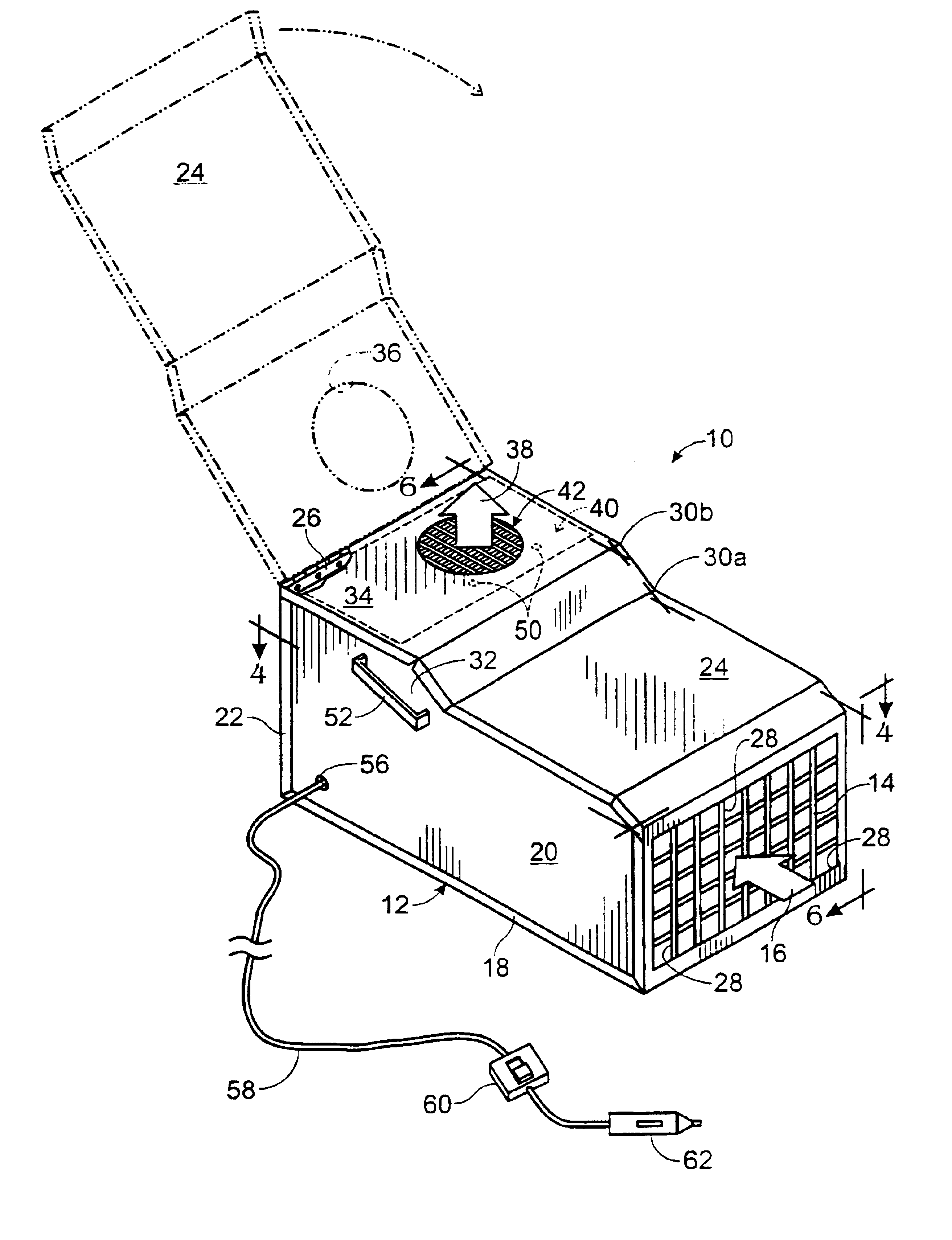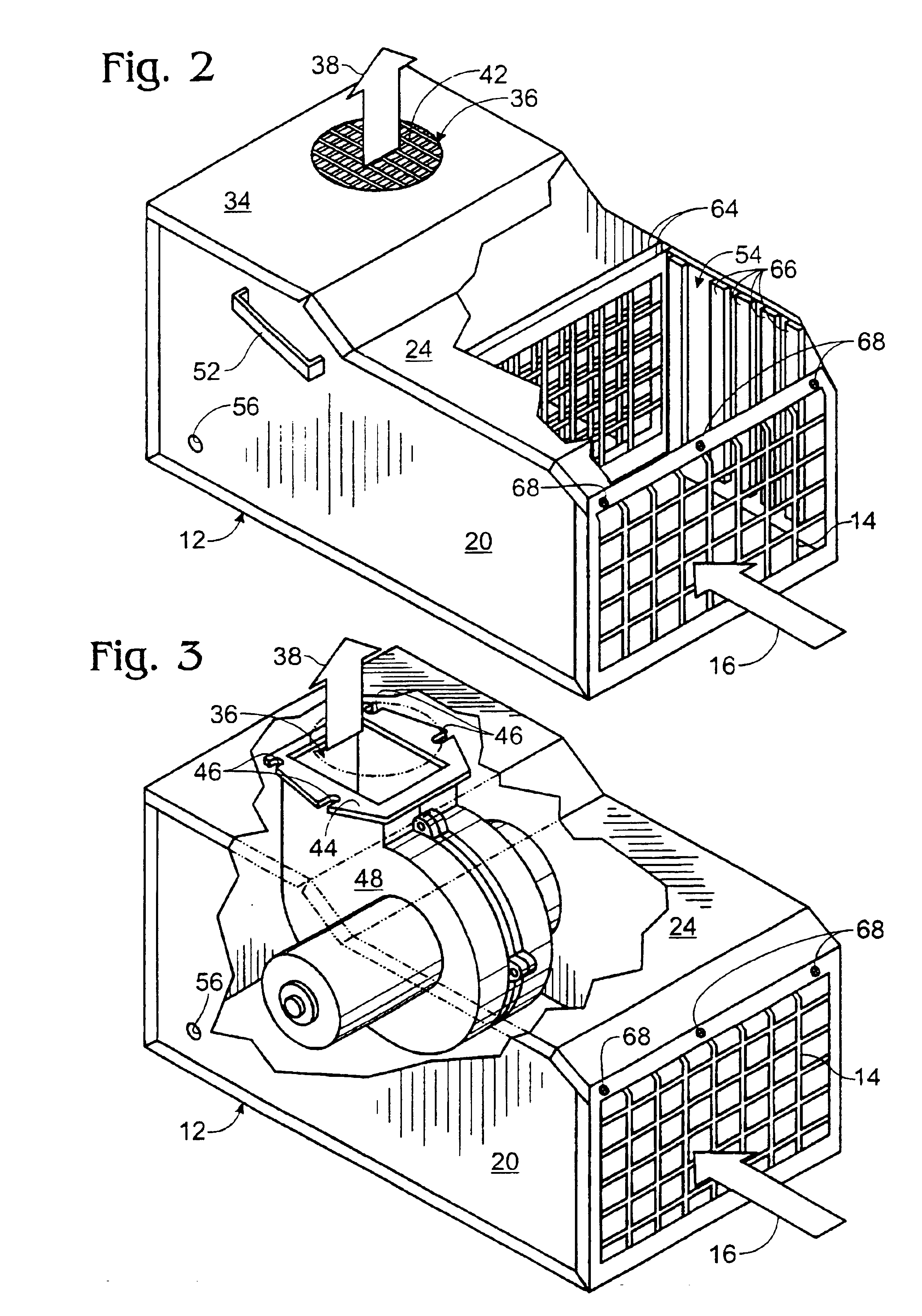With hundreds of different kinds of
air pollutants around and inside motor vehicles traveling on congested highways, this is no easy task.
These ventilation subsystems are intended to capture particles that are 3 to 8 microns in
diameter and larger, but they are not designed to reduce substantially the extensive fine (2.5 micron in
diameter and smaller) particulate matter over any extended period of time.
The electric charges on these media help to capture
fine particulate matter; however, as the
filter media fills, the charge and thus the effectiveness of such media are diminished.
These submicron particles are not effectively reduced by current ventilation subsystem designs, but yet they present the greatest
health hazard to human beings since they penetrate deeply into the
respiratory tract.
Also, placement of filters that contain
activated carbon within ventilation
system does capture some gases, but with no specific standard of effectiveness for individual gases, the object seemingly being simply that of reducing "odors" for purposes of customer satisfaction, but with little or no thought being given to the reduction of any identified pollutants.
One major limitation inherent in such systems also is that they have been designed to minimize pressure drop in order to maintain a strong flow of air, for purposes of heating or cooling, but as a result any actual fine particle purification of the air being circulated becomes minimal.
These, too, have had little or no capacity to rapidly filter and re-circulate cabin air.
In most cases, the stand-alone devices of the prior art have had insufficient air flow to reduce substantially the continuing flow of pollutants that comes into the vehicle cabin through the ventilation
system, and through leakage around
doors and windows.
Also, no prior art device intended for vehicle cabin
air purification that is known to this inventor has targeted the specific
air pollutants for which the EPA or other agencies have established ambient air quality standards, with the goal of reducing the concentration levels of those pollutants at least to below the defined health standards.
For example, the
web site http: / / www.realgoods.com / shop / shop.1.cfm?dp=107&ts=1053857 operated by Real Goods offers a three-stage auto
air filter that employs
activated carbon, an
electret charged medium, and a
Zeolite VOC ("Volatile Organic Compounds") filter, but the
efficacy of the device is not known, other than claiming to recycle the cabin air in about six minutes.
125), that "conventional high efficiency filters operate at low
filtration velocities and excessively large spaces would be required to accommodate these filters in a car," and(p.
126) that "current ventilation system designs do not allow for the incorporation of conventional high efficiency filters (
HEPA) typically required if `
lung damaging` particles have to be removed."
145-146) that with respect to
odor control, "under the flow conditions common in this application, adsorbent media did not have sufficient efficiency and life to remove challenge substances."
Because the levels found at road-side monitoring stations in many major cities now exceed in themselves the health standards established by the U.S. EPA, the much higher levels of those same pollutants inside vehicles can present an even more significant
health risk to passengers.
This same problem exists worldwide, and is rapidly getting worse.
Yet this growth has come at a cost.
Swelling urban populations and increased concentration of industry and automobile traffic in and around cities has resulted in severe
air pollution .
These developments are reflected in the city's deteriorated air quality.
Overall, traffic and industries are the main sources of
air pollution in Jakarta.
Resuspension from roads, diesel and
gasoline vehicle emissions, and domestic wood and refuse burning are the main sources of
particulate pollution.
Drivers, roadside residents, and those who live near large sources are most severely affected.
While attaching an economic value to morbidity and mortality
stemming from
air pollution can be difficult, there is anecdotal as well as estimated evidence to suggest that the health of Jakarta's residents is under assault.
Those health risks will of course include the possible spread and
inhalation of airborne infectious agents, particularly in the case of vehicles that accept transient passengers as part of their daily function, such as police cars, limousines, taxicabs and ambulances.
With the exception of certain special purpose applications, such as the Kraw et al. patent that is principally concerned with mercury in
dental offices, or the Benedict patent which treats only
sulfur compounds (only one of which,
sulfur dioxide, ranks as a major criteria air
pollutant), and in
spite of the EPA
documentation of this pressing need for "
speciation" of the offending materials, the prior art discloses little attempt to address the issue of motor vehicle cabin air
pollution in terms of specific chemical elements or compounds, notably those that are know to be toxic, and / or for which standards for air purity have been defined.
Even reported efficiency values are difficult to interpret.
A study published by the South Coast Air Quality District in California determined that among all the air toxics measured inside the cabins of operating motor vehicles, benzene presented the greatest
health risk for commuters in the Los Angeles basin.
Suggestions as to what might ideally be done were not provided in any structural detail, evidently in light of the much greater emphasis on minimal "customer satisfaction" as a tool in marketing, and thus an unwillingness to invest in the development of truly effective filter systems.
The motor vehicle cabin also presents a particularly difficult problem in reducing air
pollution, since the vehicle cabin is not a
closed system, but "new" air is continually being drawn into it through the vehicle ventilation system.
Ventilation systems that have a "recirculate" mode will tend to decrease the amount of such "new" air that is being drawn in, of course, but there will still be some amount of "new" (and polluted) air being drawn in.
 Login to View More
Login to View More 


